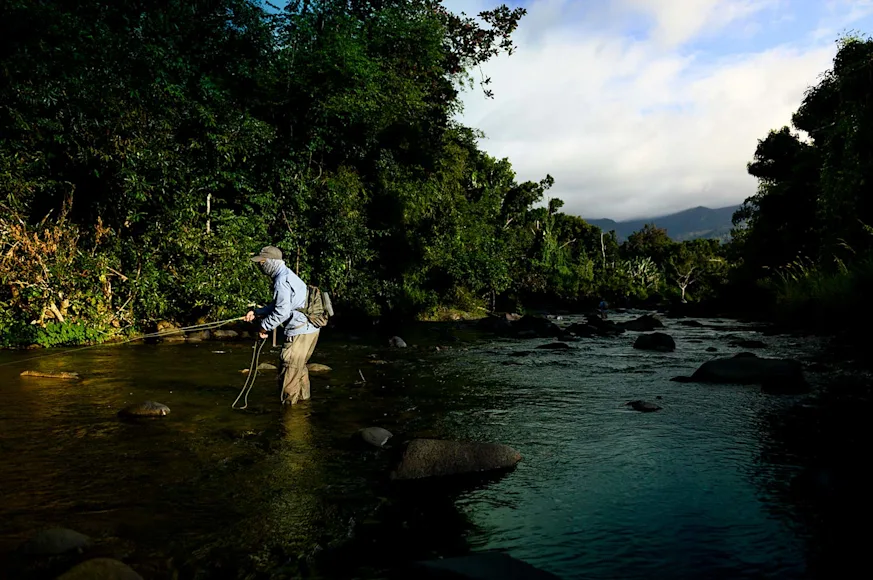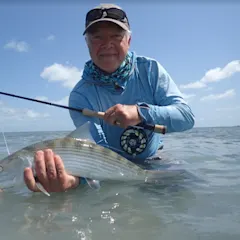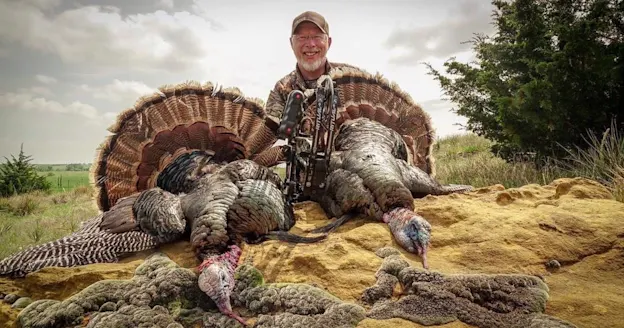The saints watched from the crook of a massive, gnarled, and knotted tree: Saint Ursula clutched a sword, and beneath her a warrior held her scepter. Ursula, legend holds, was a British princess martyred in Germany in the 4th century, along with as many as 11,000 of her holy companions. Now two-foot-tall statues of the saints, nestled in an ancient tree at the end of a jungled foot trail, gaze over a wild Puerto Rican river. Rivers of wax from prayer candles flowed like lava down the trunk. A small platter held a smudge of old incense ashes.
“I’m not going to lie,” said my son, Jack, as he threaded the tip of his fly rod through the vines dripping beneath Ursula’s robes. “This is a little freaky.”
But there was nothing to fear. For centuries, the Puerto Rican faithful have placed wooden figurines of saints—santos—in their homes as altars for prayer and offering, a tradition born of rural people who had limited access to churches. We passed under the santos —Jack, myself, my buddy Nate Matthews, and Craig Lilyestrom, retired director of Puerto Rico’s Marine Resources Division—and waded into the clear waters of the Espírito Santo River, four anglers a long way from home, with fly rods and lightweight spinning gear and only the faintest idea of what we were doing.
A slight shiver ran down my spine, and I looked over my shoulder to catch a last glimpse of the santos, barely visible in the trees. I wished I had packed a candle in my sling pack. Perhaps I should have hooked a dry fly into the bark below Saint Ursula’s robe, a token of respect and hope. Given the nature of our quest—to find and catch some of the strangest and least-known fish in America—I’d take all the supernatural help I could get.
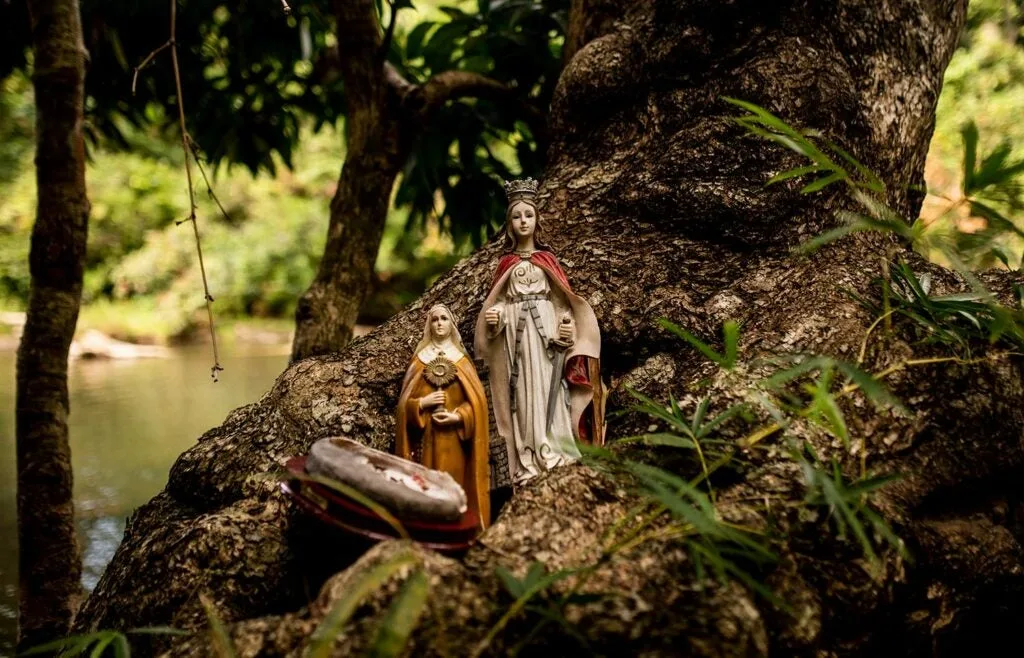
Statues of saints look over the Espírito Santo River. Stephen Maturin
A Plan Comes Together
I first heard of Puerto Rico’s funky fish species on a research trip a decade ago, and I’ve kept a folder of science papers on the subject ever since. Scores of short, steep tropical rivers fall from the high peaks of the Cordillera Central and the El Yunque rainforest to coastal lagoons ringed with mangroves and sand flats. Within a few hours’ hike there are mountain canyons and rich estuaries, and a host of native Caribbean fishes that never see a headline. There’s the gem-like sriracha goby that sports suction cups on its fins so it can scale waterfalls in the rainforest. Foot-long freshwater shrimp. The bigmouth sleeper, a fanged fish shaped like a flat torpedo to help it burrow in the river bottom and hang on during the frequent flash floods of the river canyons. These fish crush baitfish as aggressively as a northern pike, but other than a few locals fishing for the table, no one targets bigmouth sleeper.
And then there’s the mountain mullet. This was my Holy Grail—a catadromous, trout-like mullet that lives in the clear rivers that tumble from the mountains. Google “mountain mullet fishing,”
and the Internet gives you nearly nothing. There’s a blog post from some dude living in a treehouse on the west coast of Costa Rica. A sparse Reddit thread. An 1872 magazine story from Jamaica. Locals call the fish dajao, and catch it on tiny pieces of avocado. But recreational fishing is nil. Many Puerto Ricans don’t even know this fish exists, much less whether they will take a dry fly.
.embed-container { position: relative; padding-bottom: 56.25%; height: 0; overflow: hidden; max-width: 100%; } .embed-container iframe, .embed-container object, .embed-container embed { position: absolute; top: 0; left: 0; width: 100%; height: 100%; }
A few months before my trip, at a pint night for Backcountry Hunters & Anglers, serendipity struck. I ran into Augustin Engman, a post-doc fisheries biologist whose passion was studying the island’s native fish, and told him about my Puerto Rico obsession, which was going nowhere. “It’s crazy,” Engman said. “You wouldn’t believe what’s down there.”
Three drinks into the conversation, I asked Engman: Could a couple of guys pull off a Puerto Rican road trip, part-guided and part-DIY, something that wouldn’t break the bank, but would feature a few of Puerto Rico’s glamour fish—tarpon and peacock bass, maybe—but roughing it for natives the rest of the time?
Engman lit up with a grin. “I don’t think anybody’s done that,” he said. “Ever.”
That was all I needed to hear.
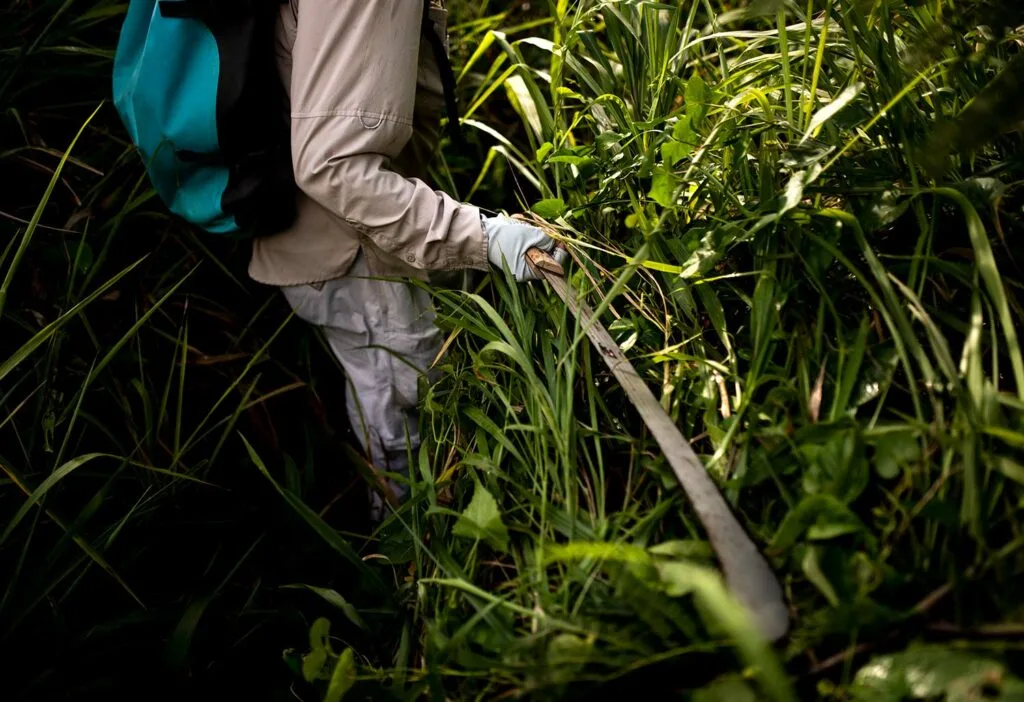
The crew bushwhacks their way to jungle waters. Stephen Maturin
A Mountain Mullet Milestone
From San Juan, we coursed east and south—the soaring, vernal bulk of the Luquillo Mountains off our right shoulder. Those high ridges see nearly 15 feet of rainfall each year, all of which thunders more than 3,500 feet to the sea in less than six miles. Clouds were snagged in the mountaintops, and Lilyestrom frowned. “These rivers can spike to 50 times normal flows in a matter of minutes,” he said. “If you see the water color up, or leaves and sticks in the main flow, get the hell out.”
Our first target was the Sabana River, with headwaters high in the El Yunque National Forest. The big creek falls through tangled greenery, the Cordillera Central high and dark in the background, but getting to the water in the lowlands is a trick. One of the charms of Puerto Rican stream fishing is accessing the stream: We parked at the end of the highway bridge, and macheted through 10-foot-tall brush to the water’s edge. Jack was the first to hack his way clear, and he immediately scattered a school of fish from a cobbled flat running clear.
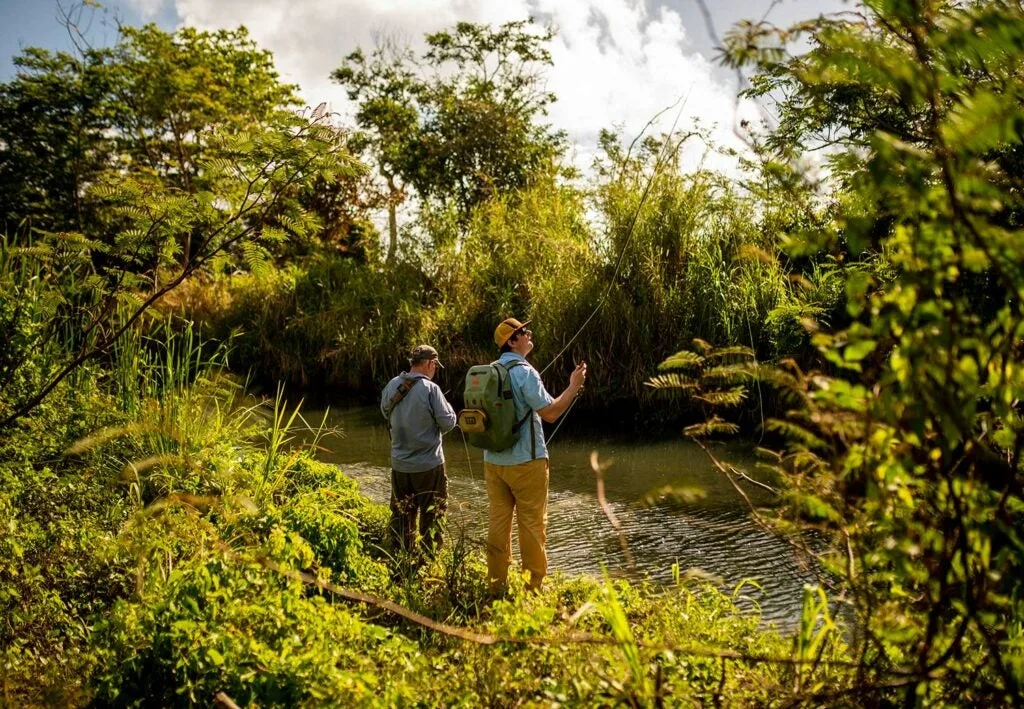
The author (left) and his son, Jack, rig fly rods on the Sabana River. Stephen Maturin
“Silver, and sort of torpedo-shaped?” Lilyestrom asked, pulling thorns from his forearm.
“Yes, sir,” Jack replied. “And a spot near the tail.”
“Mountain mullet,” Lilyestrom said. “Just has to be.”
Stoked at our possible good luck, we divvied up the braided channels and each took off in a separate direction. I had no idea what fly to fish, what kind of retrieve to make, or what sort of water to look for to catch a fish that hardly anyone seems to know anything about. Vehicle traffic buzzed downstream, and an occasional car horn blared. But otherwise, I was immersed in an otherworld of clear, running water, gravel bars, and river banks clad in a thousand shades of green. Squint, and I might imagine LeTort Spring Run in Pennsylvania or a spring creek in the Rockies.
Starting with a tiny Clouser Minnow, I fan-cast to every pool, riffle, and ledge drop within reach. Silver shapes fled. I switched to a fly that would land with a subtler splat, a little tuft of flash with tiny dumbbell eyes, and slowed down to pick the river apart for where a trout might lie. With close to nothing to go on, nothing is what I caught for nearly an hour.
Then, suddenly, Jack hollered from upstream. “Dad! Dad! Get up here!”
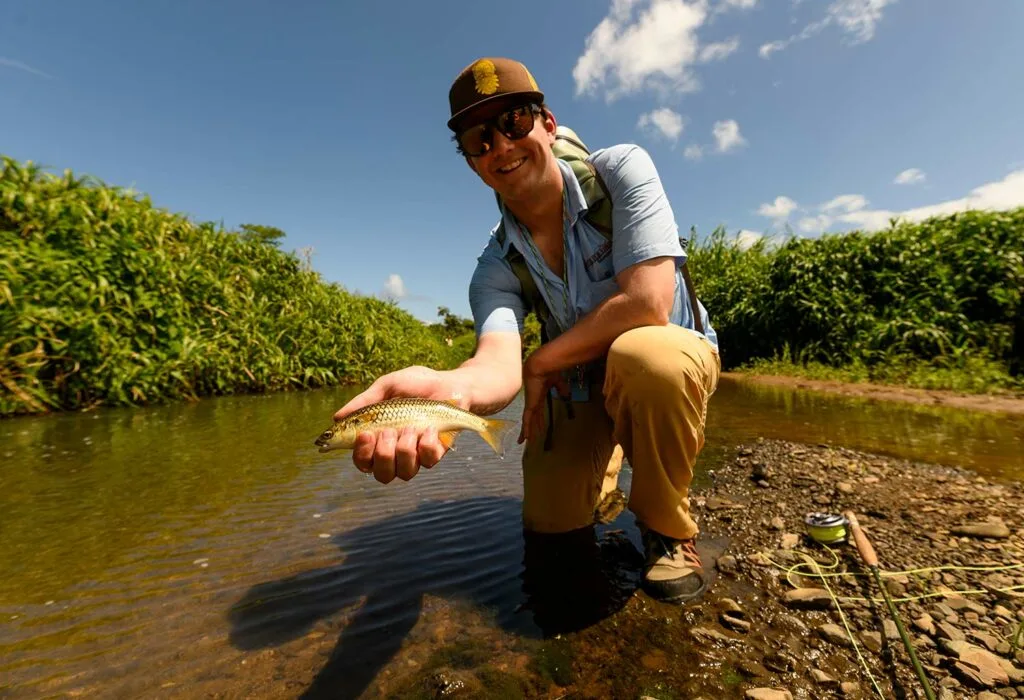
Jack Nickens shows of a mountain mullet before releasing it. Stephen Maturin
I churned through the current and jogged across a gravel bar, part of me not wanting to miss what Jack might have discovered, and another part hoping he hadn’t found himself in some kind of off-the-beaten-path trouble—bayed up by iguanas, perhaps, or with his foot trapped in a truck quarter panel rusting in the river. Instead, he was high-sticking his line for a drag-free drift along an undercut edge of the island. “Dad, it’s crazy!” he hollered, as I rounded the bend.
He was talking a mile a minute. He’d learned his lesson from the skittish fish downstream. Casting from his knees, he’d crawled a Crazy Charlie tarpon fly through a slow ledge and pool when the first fish hit. Now he’d already landed two mountain mullet and had another half-dozen follows.
“I was so zoned in, I felt like I was 50 miles from the nearest human,” he said. “I saw this run and thought: If this were Montana it would be sick with rainbows and browns. The first fish took the fly on sort of a super-duper slow swing, so I let the next cast sink to the bottom and WHAM! These fish fight like crazy!”
“Mountain mullet?” I asked.
“If think so,” he replied. “Get above me and catch one, then you tell me.”
Our gravel bar ruckus, however, had put down every fish in the stretch. We moved up the river, fishing the Sabana as if we were targeting brook trout water back home, crawling up to boulders in the middle of a mountain creek, hopscotching holes to take turns fishing, watching each other’s every cast. Every lane looked fishy, every lie, every piece of promising water that gave up nothing was analyzed. When you have no information, all information is valuable.
Jack switched to a double dry-fly rig, his go-to for cutthroat trout as a summer guide in Montana. I tied on a lightweight bead-chain Crazy Charlie, and pinched a bright-orange foam strike indicator to the leader. We were like giddy 10-year-olds that our parents had turned loose on a creek for the first time—except we carried three grand in fishing gear. Moving upstream, I stalked a broad gravel bar where the river took a hard right-hand turn, with two tongues of current cutting through shallow riffles to spill into a dark-tea pool. A retrieve through the far tongue turned up nothing, but on the second cast, I let the current carry the leader into the trough first, trailing the fly, so it would straighten and slingshot the Crazy Charlie deep under the bank.
The fish darted from the bottom of the pool in a silver flash, and the rod jumped.
Jack’s fish were hand-size. Not this one. The fish bent the 4-weight rod to the cork. It ran straight upstream, and when it surged over the ledge drop into the riffled shallows above, and I gave it all the line it wanted as it rooster-tailed through four-inch-deep water.
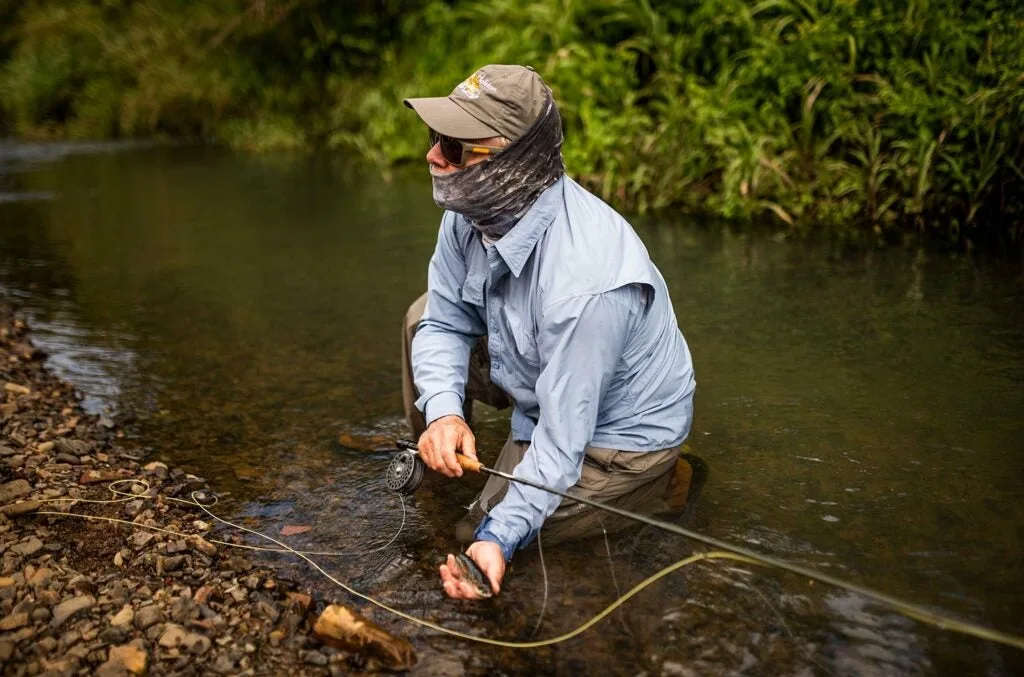
The author checks a mountain mullet off of his bucket list. Stephen Maturin
By the time I brought the fish in hand, my own whoops had alerted the team. There was the tail-spot that Jack saw earlier, a charcoal smudge. A blunt head with an omnivore’s mouth, ready to scarf down anything from a snail to a floating beetle. And the entire, elliptical, foot-long beast was armored in diamond scales with a bronzed opalescence.
We all gathered on the gravel bar to gawk. “There’s probably been less than 10 people in all of Puerto Rico that have ever caught a mountain mullet on a fly,” Lilyestrom said. “And I’m looking at two of them.”
Juiced, we talked about the exultant feeling of catching a fish—even a small fish—in an atmosphere of discovery and even doubt. We’ve all caught good fish in pretty crazy places. Matthews slings live eels for brute stripers out of a kayak in New York harbor. Jack guides for bull trout in remote Montana. But we were so worried that this wouldn’t happen, and that the stories of these fish were little more than myth. And even if they weren’t, how could we know if a mountain mullet would eat an artificial fly?
We took a few quick photos, and I released the fish into a slot of clear water in the gravel par, its scales a prismatic argyle that shimmered with all the colors of this little corner of unknown Puerto Rico—wet rocks, green banks, and blue sky.
“I’ve got to admit it,” Matthews said, “the whole trip felt like we were casting for unicorns. If you told folks back home that you could just park at a bridge, hack your way down to the creek, and basically go trout fishing in Puerto Rico, they’d never believe you.”
Of course, we weren’t winners everywhere. The next day on the Mamayes River, we roped down a steep bank beside a parking area chockablock with food trucks and locals who eyed us warily. A thunderstorm raged in blinding sheets as I sheltered under a rootball waiting for Jack and Matthews to beat it back downstream before the river rose. On another afternoon we hiked far up another headwater stream to a rumored stretch of river, but other than the four-inch snook Jack caught to bump up our species list, it was a bust.
But there for a long blissful morning on the Sabana, we had picked the lock on mountain mullet, and while it was hard to say whether we were lucky or good, one thing was certain: We were grateful.
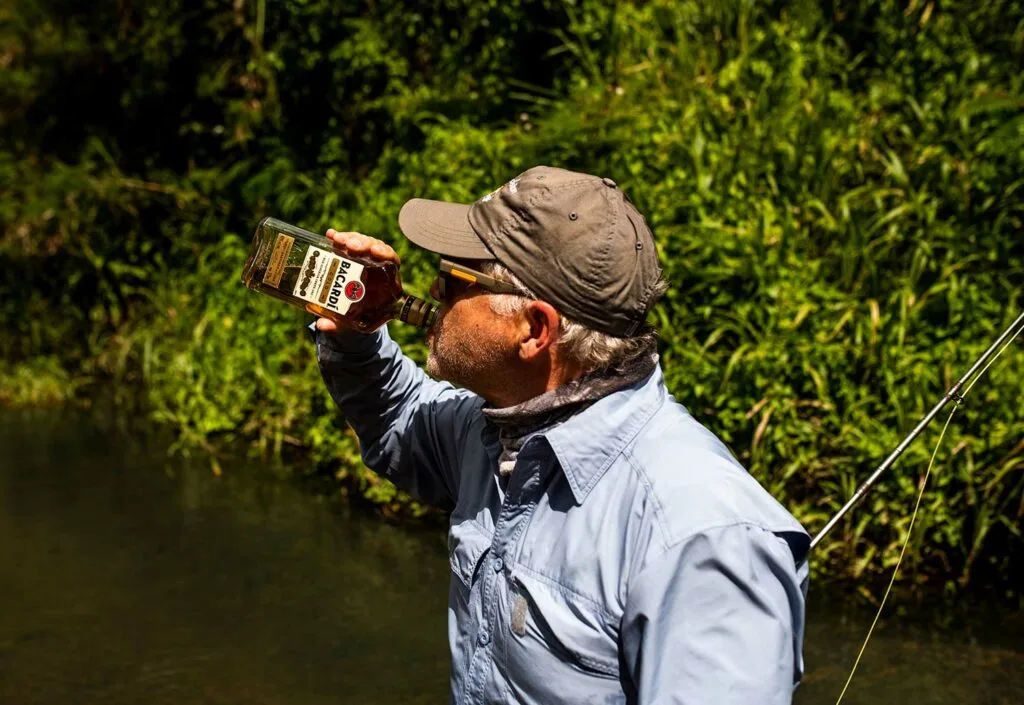
The author sips some celebratory rum after landing his first mountain mullet. Stephen Maturin
Silver Kings of the Night
Not that we were chasing spirits and myths alone. Puerto Rico is known for tarpon fishing, and we definitely had glamour shots with big fish on our road-trip wish list. Two days earlier, I’d stood on the bow deck of a flats skiff fishing under a disco ball; my fly line unfurled through a kaleidoscope of color. There was yellow from highway bridge lights, green from the boat’s bow beacon, and reds and whites from the nighttime glow of the San Juan skyline.
Captain Angel Munendez stood in the dark behind me, his voice slipping over my shoulder. “Strip the fly like you are writing a new rhythm,” he said. “Like you invent something new each time you touch the line, yes?”
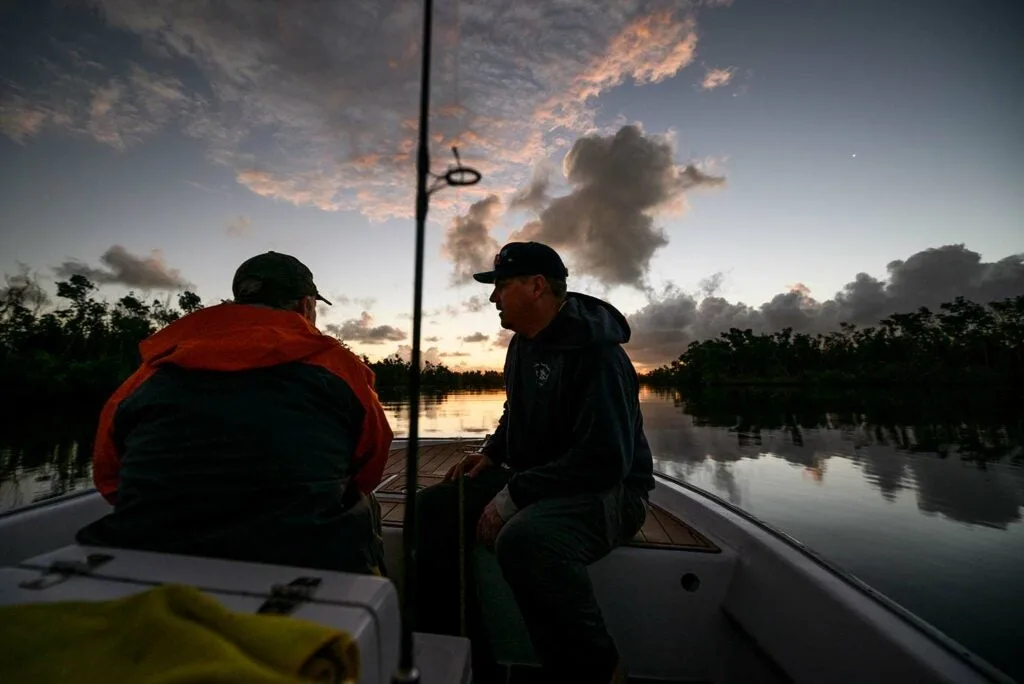
The crew motors to the tarpon grounds. Stephen Maturin
It was a beautiful way to think of this tactile connection to the fly, a relationship between the animate and inanimate, and it seemed fitting in the surreal urban wilds of San Juan. Five massive lagoons wind through the city, interconnected with mangrove-lined creeks and canals. At sunset, we would cruise the seawalls of upscale neighborhoods where couples at dinner were silhouetted in their dining rooms a few dozen yards from our casts. We’d duck into side channels where frogs called in the night and music spilled out of waterfront bars. Then we’d round a corner of mangrove canal, and the city skyline rose all around. We had our butts handed to us in that saltwater maze.
At sunrise we’d paddle sea kayaks from the landing at Tarpon’s Nest, a boutique hotel that caters to tarpon freaks, into Laguna La Torrecilla with the sound of surf on the far side of the mangroves and white egrets crowding the near shoreline. Huge schools of tarpon would surround us, and fish rolled in every direction, breeching in great toilet-flushes of exploding water 10 feet from the boats. None would eat. As trade winds rose from the east, conditions worsened. Zeroed out in five hours of hard fishing, we headed back to Tarpon’s Nest to lick our wounds.
All of which was in my mind as I sent my 300th cast into the disco ball of Laguna San Jose. “It’s like roulette,” Munendez said. “You cannot know if five-pound tarpon or 200-pound tarpon is there, but be ready for all.”
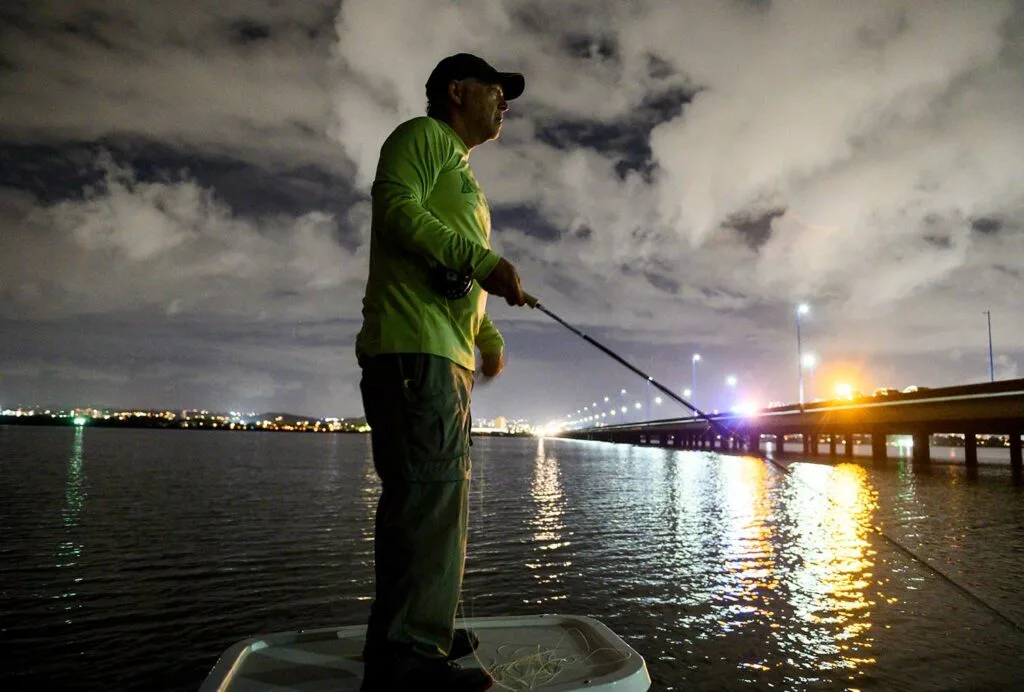
The author fishes for evening tarpon outside San Juan. Stephen Maturin
When the tarpon hit, I can’t say if I were inventing something new or simply stripping the fly blindly. But the silver fish leapt immediately in the dark, and I dropped the rod tip to feed slack to the line, and the fish leapt again—this time lit up in the rainbow lights of San Juan.
I felt relief and redemption, two emotions I would come to know well. It would be two more days later that I would genuflect to Saint Ursula, dipping low under her candle-scented altar above the Espírito Santo River. But in the spangled light of urban San Juan, with the fly line running through the rod guides toward the tarpon in the night, this fish already felt like a blessing.
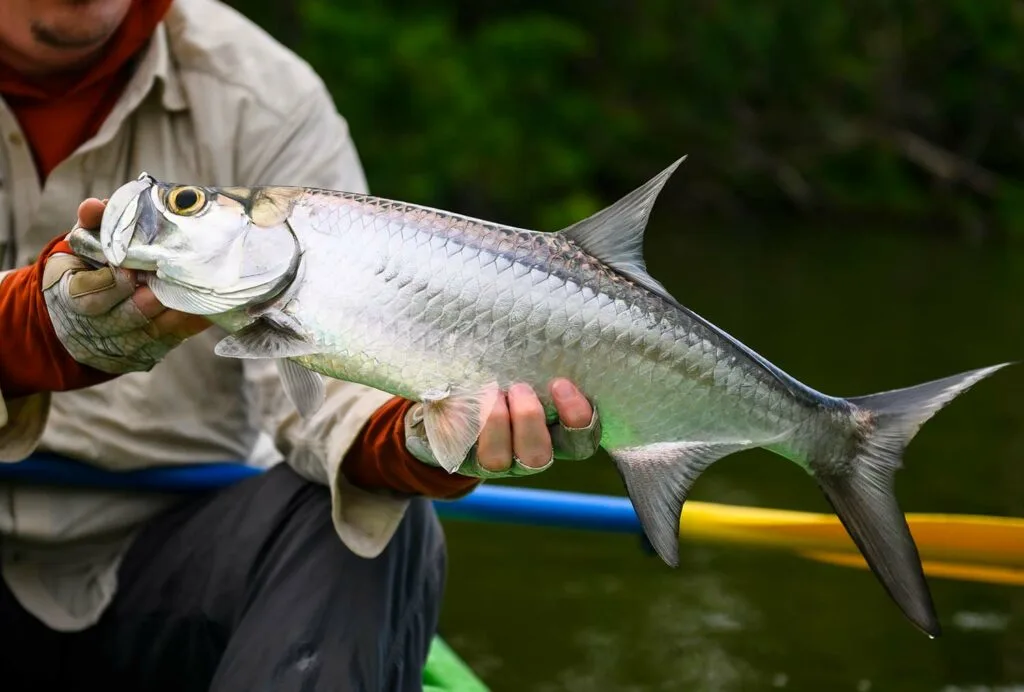
The tarpon bite was slower than the crew had hoped, but Nate Matthews managed to land this juvie silver king. Stephen Maturin
Bigmouth Sleepers in an Urban Jungle
Early the next morning we drove south through Luquillo, past the famed surfing beach with the blue Atlantic stitched with breakers from offshore reefs, to the Fajardo River. We had local intel that the Fajardo was prime hunting grounds for guabina, which means “slippery,” the local term for bigmouth sleeper. A monster might be two feet long, but even the smaller fish have a reputation for MMA-style ferocity that transcends their weight class.
Puerto Rico’s natural beauty notwithstanding, you can’t discount the reality of its contemporary challenges. Graffiti sprawled across abandoned building. Along roads and highways, mind-boggling mounds of trash littered vacant lots, creek crossings, and waterways. An estimated 18,000 tires are disposed of in Puerto Rico every day. There simply is no denying an epic trash problem.

Nate Matthews casts for bigmouth sleepers. Stephen Maturin
And there are even uglier issues surrounding Puerto Rico’s fisheries. Mountain mullet, bigmouth sleeper, and lots of other tropical fish need intact seashore, coastal lagoon, and upland rivers, all of which are under stress in Puerto Rico. Yet fisheries management in the territory is 100 years behind the rest of the country. There are practically zero regulations about fishing licenses or limits. In 2004, when the territory was thinking about passing legislation to require fishing licenses, Lilyestrom literally received death threats. Puerto Rico is much more involved in helping commercial fisherman pillage these resources than supporting what could be a top-shelf recreational destination. A 2011 NOAA report estimated that marine resources on the island could easily bring in more than $70 million a year, nearly 10 times what commercial fishing does.
So, Christmas Island, it ain’t. Which helps explain the machetes.
Near a Highway 3 bridge overpass, we parked in front of ramshackle abandoned buildings with mangy dogs eyeballing us from the shadows. Jaywalking the highway, we skirted a chain-link fence, stepping around rotting papayas and giant ant mounds. Just past the bridge I dropped down into a tangle of heavy brush, jumbled vines of morning glory, garbage bags, and dirty clothes. The jungle was thick as a kelp forest. I buried my head into my arms and battered through as my buddies waited on the bridge for a scouting report. I felt my way along the concrete bridge abutment, then dropped down into the grotto-like darkness under the bridge.
“I’m at the water,” I yelled. “Turn left at the purple panties, then just machete your way down!”
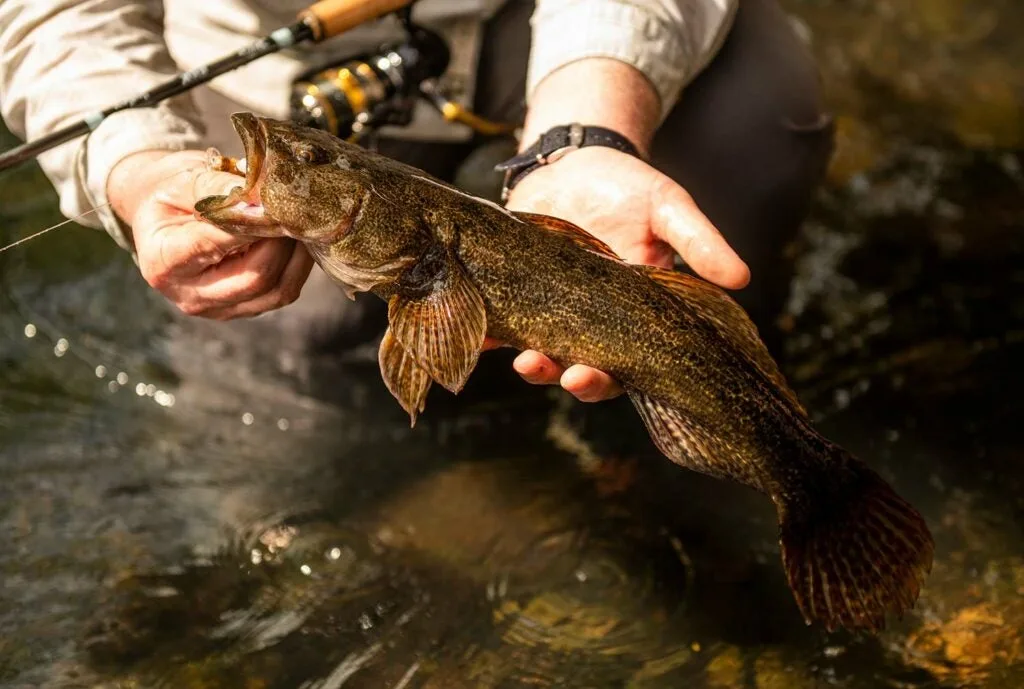
Matthews lands a trophy bigmouth beneath a highway bridge. Stephen Maturin
Beyond the bridge, past old car quarter-panels rusting in the muck, the Fajardo River flowed along gorgeous banks lined with white-barked sycamores. I struck upstream, and 50 feet from the highway the greenery closed in. Within a few steps I lost Jack in the sawgrass and Matthews in the gloom of the bridge.
I cast to the tail-outs of swift runs and dredged ultralight crankbaits through the deep pools, figuring that the fish that had eluded us so far—bigmouth sleeper—would hunker down in the slower water. I worked pool after pool of nothing. Unsure of my next move, I turned into a side channel and flipped a small crayfish floater-diver plug a few feet downstream, free-spooling the lure under a spiderweb the size of a garbage can and along a dark slash of cut bank. The fish slashed out from under the bank like the head of a state fair whack-a-mole, snatched the crayfish from the surface and turned back towards its cave.
Once I wrestled it into the open, I couldn’t believe the fish was barely 8 inches long. It lunged against the ultralight rod with a cottonmouth’s fury. Stick 10 fish in a blender and you’d end up with this Frankenstein smoothie of a predator—a trout-like tail with turquoise fin rays, spots like a walleye, and a toothy mouth that made me recoil.
I released the fish with stout forceps, and 10 steps away another sleeper crushed the crayfish. I had to run downstream to keep the 4-pound test from snapping. The sleeper wrapped line around a rock then swam to an underwater log. It held fast in the creek, a 14-inch fanged flag in a storm. I set the rod down and went in waist-deep, trying not to think about the old diapers snagged on the bank.
The crayfish came free with a twist. The sleeper had vanished. As I crawled back out of the water, I heard a shout. “You guys need to see this!” Matthews hollered. Once again, I took off running.
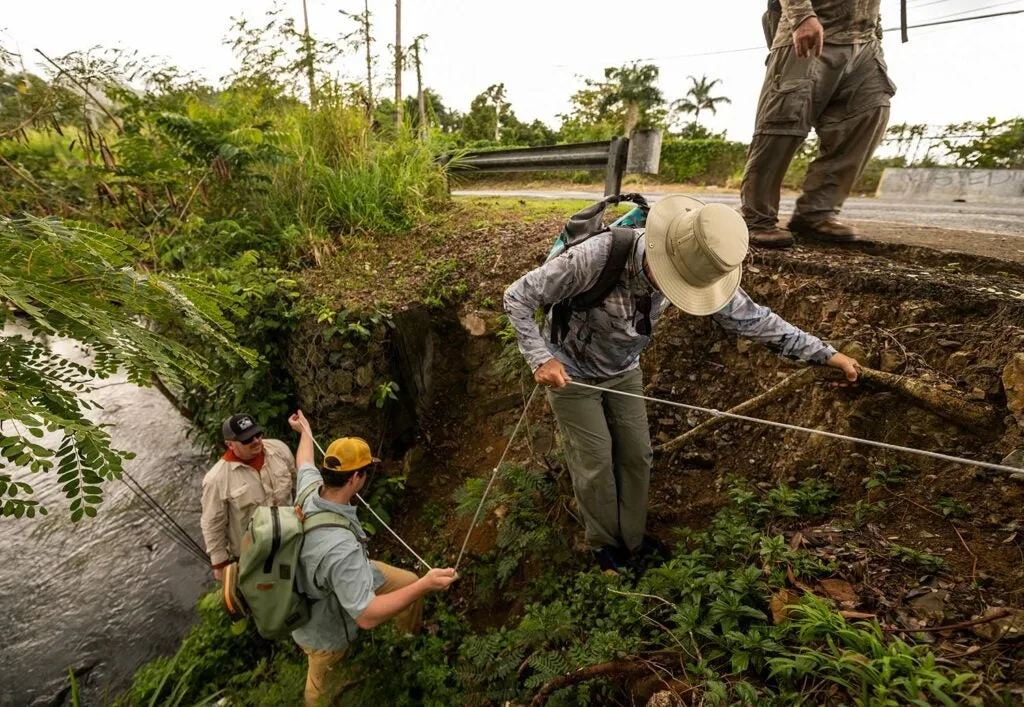
The anglers exit the river and move on to the next spot. Stephen Maturin
My buddy was on his knees in another side channel, wrenching a hook out of a 3-pound bigmouth sleeper. He’d slow-crawled his own crayfish plug up the bank edge and it was smashed by this brute of a bigmouth, which had Matthews’s fingers bleeding as he tried to remove the hook.
“Snakehead anglers back home would lose their minds over this!” he said. “Just crazy.”
He released the sleeper, and it streaked away. I half-expected it to twist like a rattler and chomp Nate’s hand on the way home. Bigmouth sleepers might not win any beauty contests, but they are native fish that need clear mountain water, unpolluted estuaries, and access to the sea. Unlovely they may be, but they are a symbol that all is not lost on Puerto Rico.
With our search image dialed in, I left Matthews to his bleeding fingers. Now I knew where guabina lived. And I hadn’t caught nearly enough of them.
Guilty-Pleasure Peacocks
We slept in late the next morning, the Atlantic surf rolling just a hundred yards from a hostel we’d booked on the beach at Luquillo. In five days, we’d fished four rivers, the San Juan lagoons, and spent one sunset surf-casting rolling breakers. My body clock was broken, the pieces cobbled together with Red Bull and Starbucks Double Shots. We had a half-day left to fish, and felt like we needed a gimme—a guilty pleasure, like a big piece of store-bought cake.

The anglers were granted permission to fish for peacock bass on a golf course. Stephen Maturin
Which is how we wound up hunting peacock bass in golf course ponds that were about as natural as a Hostess HoHo. After all our cerebral, high-minded exploratory adventures, we whacked stocked fish in a high-dollar resort while duffers shot us daggers from the greens.
Gaudy and exotic, peacocks here are a non-native creature that is everything a tarpon is not and all that a mountain mullet might stand against. And we caught whoppers. My largest fish pushed maybe eight pounds. I remember double-handing the glowing beast, gawking for photos with something that looked like I’d snagged it out of a nuclear power plant silo. Over the photographer’s shoulder rose the green-clad mountains of the Cordillera Central, those fragments of the Puerto Rican wild where the mountain mullet and bigmouth sleeper still thrive.
I felt a little guilty. After nearly a week boating, kayaking, wading, and crawling across the northeast corner of Puerto Rico, I had been convinced that this island holds world-class fishing for native fish in unforgettable places.

The author doesn’t try to hide his excitement after landing this peacock. Stephen Maturin
As I released the peacock back into its artificial home, I made a promise to return and make amends. I’ll bring a candle next time, and light it at Saint Ursula’s feet. On my map I’d marked a stretch of the Espírito Santos that seemed utterly lost to time. It would be a good place to beg the santos for a bit of fishing forgiveness.

